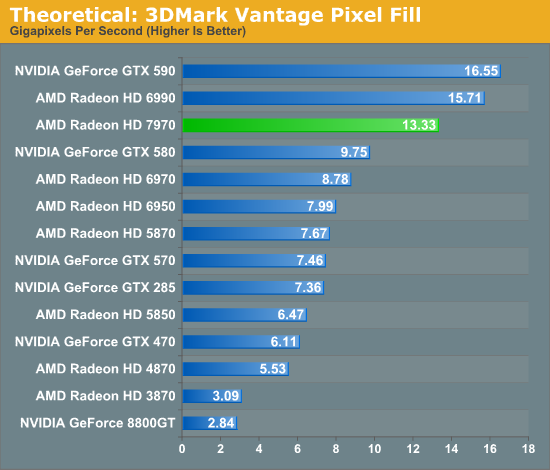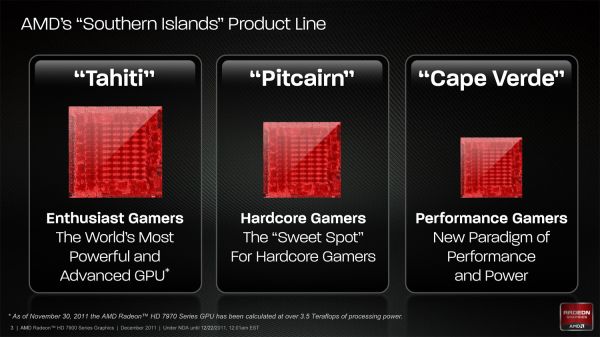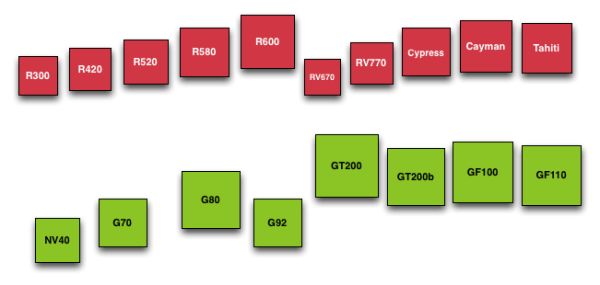AMD Radeon HD 7970 Review: 28nm And Graphics Core Next, Together As One
by Ryan Smith on December 22, 2011 12:00 AM EST- Posted in
- GPUs
- AMD
- Radeon
- ATI
- Radeon HD 7000
Building Tahiti & The Southern Islands
Now that we’ve had a chance to go over the basis of the Graphics Core Next architecture, let’s talk about the finished products.
Today AMD will be launching Tahiti, the first GPU of the Southern Islands family. Southern Islands will initially be composed of 3 GPUs: Tahiti, Pitcairn, and Cape Verde. Tahiti is the largest and most powerful member of the Southern Islands family, while Pitcairn and Cape Verde get progressively smaller. AMD has not yet announced the branding or launch dates for Pitcarn and Cape Verde, but it typically takes AMD around 6 months to launch a complete family. As such it’s reasonable to expect that all 3 GPUs will have launched by the end of June although there’s a good likelihood of it happening sooner than that.
All 3 GPUs are based on the GCN architecture, and as family members will have similar features while varying the number of functional units accordingly. Along with the architecture change Southern Islands brings with it a slew of additional features that we’ll get to in the following pages, including Partially Resident Texture (PRT) support, PCIe 3.0, FastHDMI, Direct3D 11.1, and AMD’s fixed-function H.264 encoder, the Video Codec Engine.
But today is all about Tahiti, so let’s get down to business.
As we quickly covered in our introduction, Tahiti is a 4.31B transistor GPU based on the GCN architecture and built on TSMC’s new 28nm High-K process. Due to TSMC canceling their 32nm process last year AMD has had to wait over 2 years for the next full node rather than taking advantage of the half-node process as they typically do, and as a result the jump from Cayman at 40nm to Tahiti at 28nm is much bigger than with past product launches. Whereas Cayman had 2.64B transistors and a die size of 389mm2, Tahiti has a whopping 63% more transistors than Cayman and yet it’s still smaller, coming in at a slightly more petite 365mm2.
At this point AMD hasn’t provided us with the typical board power values for 7970, but we do know that PowerTune is limited to 250W. In terms of design 7970 is clearly intended to work in similar environments as the 6970, in which case power consumption should be similar to the 6970.
Interestingly enough however we’re hearing that 7970 cards are proving to be very overclockable, which is a good sign for the state of TSMC’s 28nm process, and at the same time a bit distressing. Moore’s Law has continued to hold with respect to transistor density, but the power consumption benefits of using smaller nodes has continued to wane. Having a lot of overclocking headroom means that the 7970 has the potential to be much faster, but it also means that the 7970 (and 28nm GPUs in general) are going to be bottlenecked by power. In which case seeing as how we’re already approaching 300W with single-GPU video cards, the performance gains realized from future fabrication processes would be limited to the ever diminishing returns on power consumption improvements.
Diving deeper into Tahiti, as per the GCN architecture Tahiti’s 2048 SPs are organized into 32 Compute Units. Each of these CUs contains 4 texture units and 4 SIMD units, along with a scalar unit and the appropriate cache and registers. At the 7970’s core clock of 925MHz this puts Tahiti’s theoretical FP32 compute performance at 3.79TFLOPs, while its FP64 performance is ¼ that at 947GFLOPs. As GCN’s FP64 performance can be configured for 1/16, ¼, or ½ its FP32 performance it’s not clear at this time whether the 7970’s ¼ rate was a hardware design decision for Tahiti or a software cap that’s specific to the 7970. However as it’s obvious that Tahiti is destined to end up in a FireStream card we will no doubt find out soon enough.
Meanwhile the frontend/command processor for Tahiti is composed of 2 Asynchronous Command Engines (ACEs) and 2 geometry engines. Just as with Cayman each geometry engine can dispatch 1 triangle per clock, giving Tahiti the same theoretical 2 triangle/clock rate as Cayman. As we’ll see however, in practice Tahiti will be much faster than Cayman here due to efficiency improvements.
Looking beyond the frontend and shader cores, we’ve seen a very interesting reorganization of the rest of the GPU as opposed to Cayman. Keeping in mind that AMD’s diagrams are logical diagrams rather than physical diagrams, the fact that the ROPs on Tahiti are not located near the L2 cache and memory controllers in the diagram is not an error. The ROPs have in fact been partially decoupled from the L2 cache and memory controllers, which is also why there are 8 ROP partitions but only 6 memory controllers. Traditionally the ROPs, L2 cache, and memory controllers have all been tightly integrated as ROP operations are extremely bandwidth intensive, making this a very unusual design for AMD to use.
As it turns out, there’s a very good reason that AMD went this route. ROP operations are extremely bandwidth intensive, so much so that even when pairing up ROPs with memory controllers, the ROPs are often still starved of memory bandwidth. With Cayman AMD was not able to reach their peak theoretical ROP throughput even in synthetic tests, never mind in real-world usage. With Tahiti AMD would need to improve their ROP throughput one way or another to keep pace with future games, but because of the low efficiency of their existing ROPs they didn’t need to add any more ROP hardware, they merely needed to improve the efficiency of what they already had.
The solution to that was rather counter-intuitive: decouple the ROPs from the memory controllers. By servicing the ROPs through a crossbar AMD can hold the number of ROPs constant at 32 while increasing the width of the memory bus by 50%. The end result is that the same number of ROPs perform better by having access to the additional bandwidth they need.

The big question right now, and one we don’t have an answer to, is what were the tradeoffs for decoupling the ROPs? Clearly the crossbar design has improved ROP performance through the amount of memory bandwidth they can access, but did it impact anything else? The most obvious tradeoff here would be for potentially higher latency, but there may be other aspects that we haven’t realized yet.
On that note, let’s discuss the memory controllers quickly. Tahiti’s memory controllers aren’t significantly different from Cayman’s but there are more of them, 50% more in fact, forming a 384bit memory bus. AMD has long shied away from non-power of 2 memory busses, and indeed the last time they even had a memory bus bigger than 256bits was with the ill-fated 2900XT, but at this point in time AMD has already nearly reached the practical limits of GDDR5. AMD’s ROPs needed more memory bandwidth, but even more than that AMD needed more memory bandwidth to ensure Tahiti had competitive compute performance, and as such they had little choice but to widen their memory bus to 384bits wide by adding another 2 memory controllers.
It’s worth noting though that the addition of 2 more memory controllers also improves AMD’s cache situation. With 128KB of L2 cache being tied to each memory controller, the additional controllers gave AMD 768KB of L2 cache, rather than the 512KB that a 256bit memory bus would be paired with.














292 Comments
View All Comments
B3an - Thursday, December 22, 2011 - link
Anyone with half a brain should have worked out that being as this was going to be AMD's Fermi that it would not of had a massive increase for gaming, simply because many of those extra transistors are there for computing purposes. NOT for gaming. Just as with Fermi.The performance of this card is pretty much exactly as i expected.
Peichen - Friday, December 23, 2011 - link
AMD has been saying for ages that GPU computing is useless and CPU is the only way to go. I guess they just have a better PR department than Nvidia.BTW, before suggesting I have suffered brain trauma, remember that Nvidia delivered on Fermi 2 and GK100 will be twice as powerful as GF110
CeriseCogburn - Thursday, March 8, 2012 - link
Well it was nice to see the amd fans with half a heart admit amd has accomplished something huge by abandoned gaming, as they couldn't get enough of screaming it against nvidia... even as the 580 smoked up the top line stretch so many times...It's so entertaining...
CeriseCogburn - Thursday, March 8, 2012 - link
AMD is the dumb company. Their dumb gpu shaders. Their x86 copying of intel. Now after a few years they've done enough stealing and corporate espionage to "clone" Nvidia architecture and come out with this 7k compute.If they're lucky Nvidia will continue doing all software groundbreaking and carry the massive load by a factor of ten or forty to one working with game developers, porting open gl and open cl to workable programs and as amd fans have demanded giving them PhysX ported out to open source "for free", at which point it will suddenly be something no gamer should live without.
"Years behind" is the real story that should be told about amd and it's graphics - and it's cpu's as well.
Instead we are fed worthless half truths and lies... a "tesselator" in the HD2900 (while pathetic dx11 perf is still the amd norm)... the ddr5 "groundbreaker" ( never mentioned was the sorry bit width that made cheap 128 and 256 the reason for ddr5 needs)...
Etc.
When you don't see the promised improvement, the radeonites see a red rocket shooting to the outer depths of the galaxy and beyond...
Just get ready to pay some more taxes for the amd bailout coming.
durinbug - Thursday, December 22, 2011 - link
I was intrigued by the comment about driver command lists, somehow I missed all of that when it happened. I went searching and finally found this forum post from Ryan:http://forums.anandtech.com/showpost.php?p=3152067...
It would be nice to link to that from the mention of DCL for those of us not familiar with it...
digitalzombie - Thursday, December 22, 2011 - link
I know I'm a minority, but I use Linux to crunch data and GPU would help a lot...I was wondering if you guys can try to use these cards on Debian/Ubuntu or Fedora? And maybe report if 3d acceleration actually works? My current amd card have bad driver for Linux, shearing and glitches, which sucks when I try to number crunch and map stuff out graphically in 3d. Hell I try compiling the driver's source code and it doesn't work.
Thank you!
WaltC - Thursday, December 22, 2011 - link
Somebody pinch me and tell me I didn't just read a review of a brand-new, high-end ATi card that apparently *forgot* Eyefinity is a feature the stock nVidia 580--the card the author singles out for direct comparison with the 7970--doesn't offer in any form. Please tell me it's my eyesight that is failing, because I missed the benchmark bar charts detailing the performance of the Eyefinity 6-monitor support in the 7970 (but I do recall seeing esoteric bar-chart benchmarks for *PCIe 3.0* performance comparisons, however. I tend to think that multi-monitor support, or the lack of it, is far more an important distinction than PCIe 3.0 support benchmarks at present.)Oh, wait--nVidia's stock 580 doesn't do nVidia's "NV Surround triple display" and so there was no point in mentioning that "trivial fact" anywhere in the article? Why compare two cards so closely but fail to mention a major feature one of them supports that the other doesn't? Eh? Is it the author's opinion that multi-monitor gaming is not worth having on either gpu platform? If so, it would be nice to know that by way of the author's admission. Personally, I think that knowing whether a product will support multi monitors and *playable* resolutions up to 5760x1200 ROOB is *somewhat* important in a product review. (sarcasm/massive understatement)
Aside from that glaring oversight, I thought this review was just fair, honestly--and if the author had been less interested in apologizing for nVidia--we might even have seen a better one. Reading his hastily written apologies was kind of funny and amusing, though. But leaving out Eyefinity performance comparisons by pretending the feature isn't relative to the 7970, or that it isn't a feature worth commenting on relative to nVidia's stock 580? Very odd. The author also states: "The purpose of MST hubs was so that users could use several monitors with a regular Radeon card, rather than needing an exotic all-DisplayPort “Eyefinity edition” card as they need now," as if this is an industry-standard component that only ATi customers are "asking for," when it sure seems like nVidia customers could benefit from MST even more at present.
I seem to recall reading the following statement more than once in this review but please pardon me if it was only stated once: "... but it’s NVIDIA that makes all the money." Sorry but even a dunce can see that nVidia doesn't now and never has "made all the money." Heh...;) If nVidia "made all the money," and AMD hadn't made any money at all (which would have to be the case if nVidia "made all the money") then we wouldn't see a 7970 at all, would we? It's possible, and likely, that the author meant "nVidia made more money," which is an independent declaration I'm not inclined to check, either way. But it's for certain that in saying "nVidia made all the money" the author was--obviously--wrong.
The 7970 is all the more impressive considering how much longer nVidia's had to shape up and polish its 580-ish driver sets. But I gather that simple observation was also too far fetched for the author to have seriously considered as pertinent. The 7970 is impressive, AFAIC, but this review is somewhat disappointing. Looks like it was thrown together in a big hurry.
Finally - Friday, December 23, 2011 - link
On AT you have to compensate for their over-steering while reading.Death666Angel - Thursday, December 22, 2011 - link
"Intel implemented Quick Sync as a CPU company, but does that mean hardware H.264 encoders are a CPU feature?" << Why is that even a question. I cannot use the feature unless I am using the iGPU or use the dGPU with Lucid Virtu. As such, it is not a feature of the CPU in my book.Roald - Thursday, December 22, 2011 - link
I don't agree with the conclusion. I think it's much more of a perspective thing. Comming from the 6970 to the 7970 it's not a great win in the gaming deparment. However the same can be said from the change from 4870 to 5870 to 6970. The only real benefit the 5870 had over the 4870 was DX11 support, which didn't mean so much for the games at the time.Now there is a new architechture that not only manages to increase FPS in current games, it also has growing potential and manages to excell in the compute field aswell at the same time.
The conclusion made in the Crysis warhead part of this review should therefore also have been highlighted as finals words.